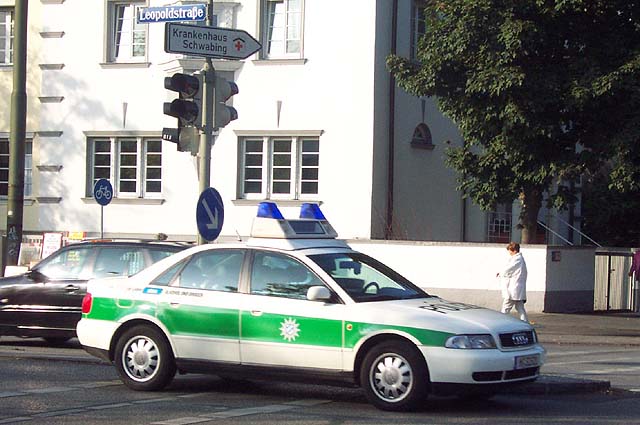
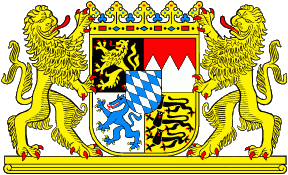
We woke up excited to get out and see things in Schwabing, the part of Munich we stayed in. As we walked to the subway we saw an Audi A4 Munich police car. This was neat because I have an Audi A4. Mine does not have the cool blue lights on top however. The police sirens made the same siren sound that you hear in a Pink Panther movie.

I was stunned by all of the interesting cars in Germany. I am a car nut in general, but a German car nut particularly, so the many Audi, BMW, Mercedes-Benz, and VW cars that I saw gave me whiplash, since 90% of the cars are one of these German brands. Here I admired an older Mercedes from the 1970s, with its European headlights.
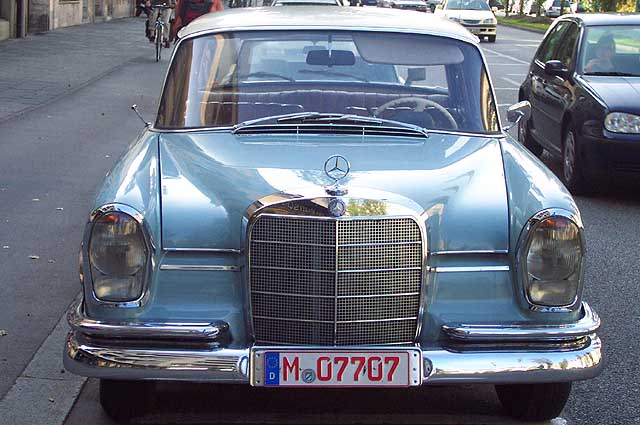
My grandfather specially ordered headlights just like these for his Mercedes in the late 1960s and early 1970s. They had a great look to them. Here is what the European headlights look like up close:
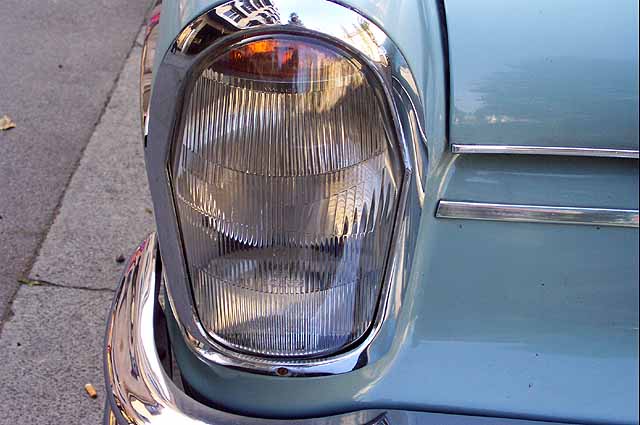
Here is another neat vehicle: a Mercedes Benz minivan used by the police. The Mercedes V-Class vans are not sold here in America.
Note the drug store in the background. They are all called Apotheke. This word comes from the same root as Apothecary, meaning pharmacy. These words all come from the same Latin root.
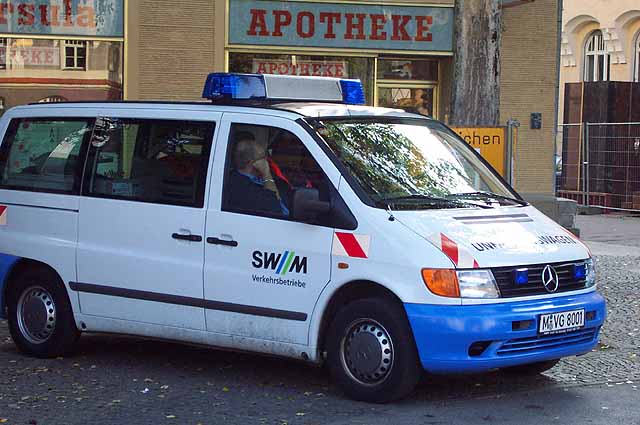
We then arrived at the subway station in Münchener Freiheit, or Munich Freedom. Subways are called the U-Bahn, or underground train. (Regular trains are called S-Bahn, for surface train.)
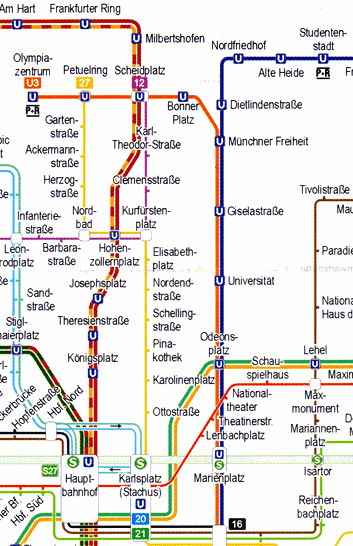
As you can see the station is very clean and well lit. We bought a single ticket which gave us (and up to 4 others) a full day of unlimited subway riding, all for DM 14.50, or about $7.25. There are no turnstyles or places to show your ticket: everything proceeds via an honor system, thus cutting down on a lot of extra bureacracy needed for ticket taking and travel restrictions. They will occasionally audit people to ensure that they are travelling legally, but we never saw this happen.

After a short ride to the Marienplatz on the U-Bahn, one comes up out of the underground subway to see this: the Neues Rathous or New City Hall. The building was built from 1867 to 1908. It is pretty amazing to see in person. At 11:00 AM many people come to see the building because of the glockenspiel.
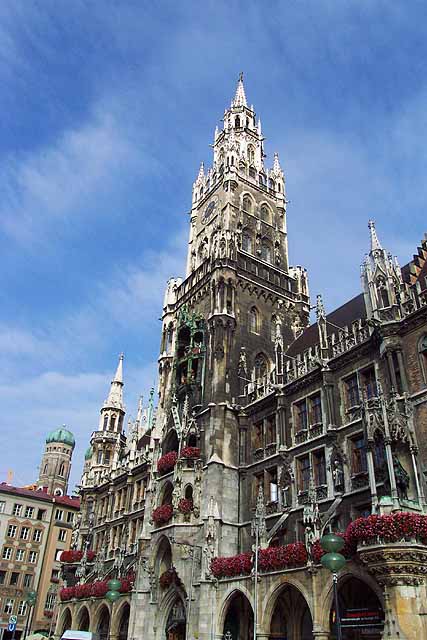
Here is the part of the building that has the glockenspiel which performs a play each day that commemorates the end of the Plague in 1517. This play is called the Dance of the Coopers or Schäfflertanz. These figures all move while music plays and at the end of the play there are two jousting knights on horses that come at each other from both sides and one knight knocks the other knight off of his horse! This glockenspiel was added in 1904.
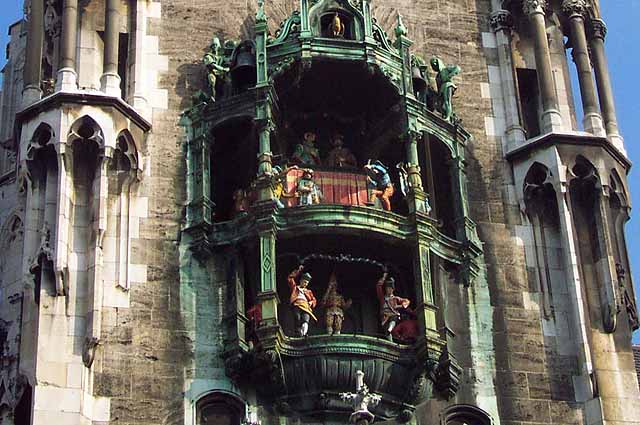
We then went up to the top of the Neues Rathous to see the city and here is the view looking northwest, with a view of Frauenkirche. This church with its twin 300 foot high towers was built in just 20 years for the main cathedral, from 1474 to 1494. The towers were added in 1524-1525. It was severely damaged in World War II and was restored from 1947 to 1957. The Olympic tower can be seen in the distance to the right in the background.
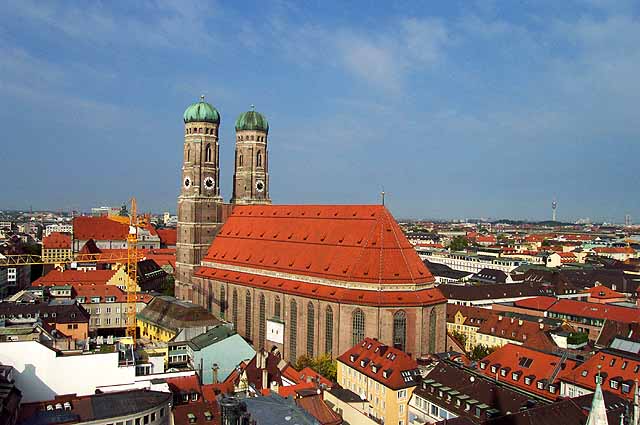
The view looking south from the tower of the Neues Rathous shows a bit of the downtown streets and if the haze were not there you would see the Alps in the distance. (We saw them another day.)
Munich takes it English name from a small village founded in the ninth century named for one of the monks in a nearby Benedictine abbey. "Munich" is old High Germany, and the town's emblem is a little monk (Münchner Kindl).
In 1156 Emperor Frederick Barbarossa ceded a part of Bavaria to Henry the Lion, Duke of Saxony, and this Duke took the salt trade taxes and Munich was begun.
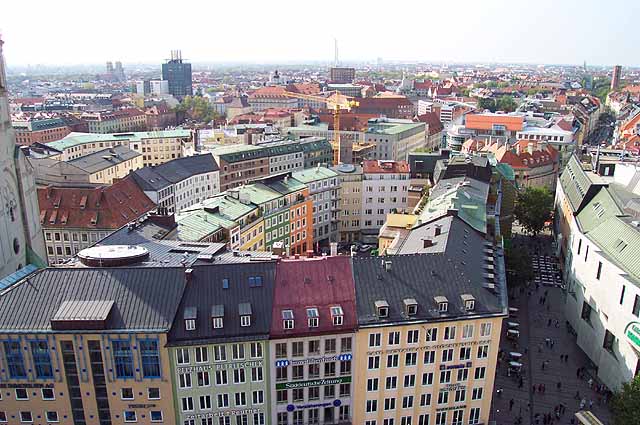
Time for lunch, so we went to the famous Hofbräuhaus. Founded in 1589, this building was built at the end of the 19th century. Hitler assembled here on occasion.
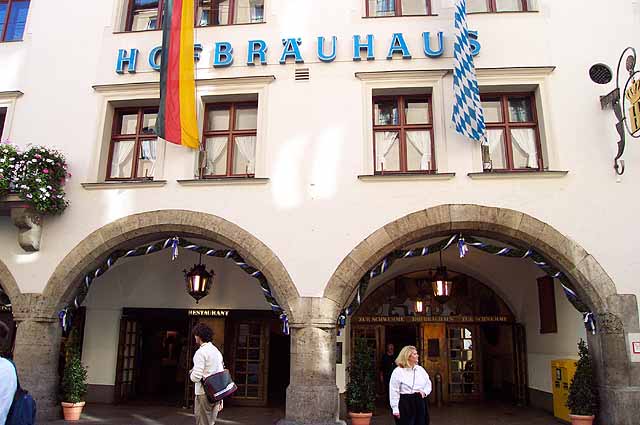
This was our first German meal, inside the Hofbräuhaus. Nobody seats you in Germany, or even tells you "sit anywhere". You just have to know to seat yourself. The menus are always left on the tables. Note the Hofbräuhaus logo on the wall in the upper left of this photo.
I had roast loin of pork and Beth had a sausage sampler. Both were very good. We enjoyed watching a table full of older men talking and drinking beer out of huge steins.
In the center of this photo you will see the HB-Festkapelle, a German folk group which plays live music. It is comprised of two trumpets, a tuba, and an accordian. It filled the hall with fun and happy music. I brought home a CD of their songs I enjoyed it so much!

After lunch it was time for a bookstore. Right on the Marienplatz was Hugendubel München, Die Welt der Bücher. The only word I understood of this title was the last word, which has the sound of "book" in it, so in we went. 3 stories tall, it was a fine bookstore with an excellent selection of maps. (Over the in back left corner in the photo.) I enjoyed browsing while Beth read a book about the nearby castles. I found several good volumes on cars and cooking and could have spent the afternoon there, but on we must go.
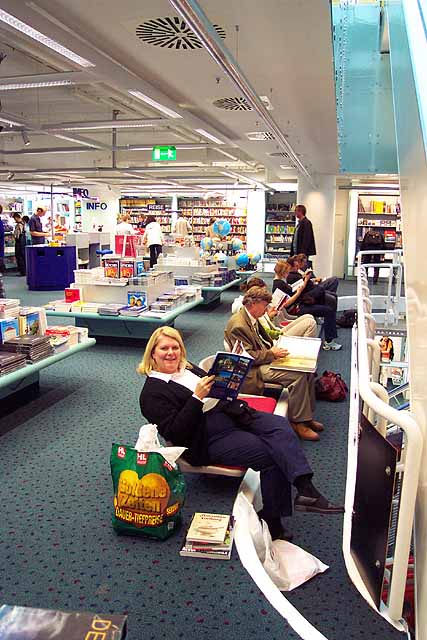
We saw quite a few Smart City cars. These are made in a joint venture by DaimlerChrysler and Swatch, the watch maker. They are cute and were quite popular. They cost about $7,000.
They seat two people. These cars are 2.5 meters (just over eight feet) long, with a turning circle of 8.7 meters (28.5 feet)! With an 799cc 3 cylinder diesel engine, the car has an electronically limited top speed of 135 kph (84 mph), does 0-100 kph (0-62mph) in 19.8 seconds, and uses only 3.1 liters per 100 km. In Europe mileages are expressed as the reciprocal of how we specify mileages. This translates to 76 mpg!

After we hit the bookstore we needed to bring the books back to the hotel room. Here is where we stayed: the Holiday Inn Munich City-North. We had a room with two queen-sized beds (but we call them doubles in America!). The room was air-conditioned, but in America we would say the room has a fan. The beds were comfortable and the room was kept spotless.
It was in the 70s while we were there, and largely sunny and we did not have much to complain about once we opened the huge window to cool off the room. We left the window open all night and heard the sirens, traffic, and amazingly got no bugs or flies in the room.
We were on floor six, which is actually floor seven. Lobbies are not called the 1st floor in Europe. The second story is therefore the first. (They are zero-based rather than one-based to use a programmer's phrase.)

Once the books were unloaded we decided to take a quick trip to Garmisch-Partenkirchen, the skiing capital of Germany. Hitler made these two towns into one for the 1936 Winter Olympics which were held here. Nearby Zugspitz is the tallest mountain in Germany at 2,964 meters, or 9.724 feet above sea level.

We left on the train after a quick subway ride to the Hauptbanhof, the main train station of Munich. It was a 90 minute ride to the south of Munich to the base of the Alps that we were headed. We left at 5:00 PM.

The scenery on the train ride was beautiful.

We rode in first class. Georg Öttl joined our compartment. He was a young man from Oldstadt, a town that the train stopped at on its way to Garmisch-Partenkirchen. He was being trained as a Munich police officer and was on his way to Garmisch-Partenkirchen to see his girlfriend. He rode free in first class as a benefit of his job. He was very nice and spoke much better English than we spoke German.
We visited with him for an hour as we rode to Garmisch-Partenkirchen. He very much wanted to visit America. I mentioned that I had not seen any American pickup trucks, and that I had a Chevy pickup. He said he really liked pickups!

Garmisch-Partenkirchen is nestled in the Alps and thus, like North Bend, has little sun at the end of the day due to the mountains. Georg told us where to go and we found the downtown after a ten minute walk.
Since we arrived after 6:00 PM, most of the businesses were closed. In fact the only businesses open were a small market that closed at 8:00 PM, and 3 restaurants: 2 German and 1 Italian. Since we were about as close as we were going to get to Italy on this trip — just 35 miles — we decided to go Italian. Our waiter and the chef spoke Italian. The food was great: Beth had Tortellini al Forno and I had Veal Valdostana.

After dinner we stopped in at the market and bought a few odds and ends. We learned that paper bags cost DM 0.30 (fifteen cents) and then did a bit of window shopping as we made our way back to the train.
We saw a beautiful traditional dress for sale in one of the little shops. Here it is:
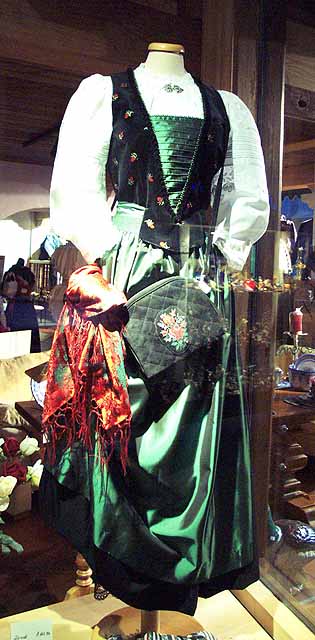
After riding the train part way to Munich they informed us that we needed to transfer to a bus for part of the journey back. We did so and drove through very dark country roads and then got on another train that returned us to Munich.
On to day 4, our day in Salzburg, Austria
Back to day 2, our afternoon in London
Back to Germany overview
Back to Dan Allen's Home Page
Created: 18 Oct 2001 Modified: 18 Oct 2001